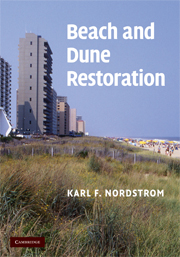Book contents
- Frontmatter
- Contents
- Preface
- Acknowledgments
- 1 The need for restoration
- 2 Beach nourishment and impacts
- 3 Dune building practices and impacts
- 4 Restoring processes, structure, and functions
- 5 Options in spatially restricted environments
- 6 A locally based program for beach and dune restoration
- 7 Stakeholder interests, conflicts, and co-operation
- 8 Research needs
- References
- Index
3 - Dune building practices and impacts
Published online by Cambridge University Press: 14 August 2009
- Frontmatter
- Contents
- Preface
- Acknowledgments
- 1 The need for restoration
- 2 Beach nourishment and impacts
- 3 Dune building practices and impacts
- 4 Restoring processes, structure, and functions
- 5 Options in spatially restricted environments
- 6 A locally based program for beach and dune restoration
- 7 Stakeholder interests, conflicts, and co-operation
- 8 Research needs
- References
- Index
Summary
Characteristics of human-altered dunes
Sand dunes are an integral component of natural sandy shore systems. Sediment is exchanged between beach and dune through erosion of the dune by storm waves, followed by delivery of sand from the beach during strong onshore winds. Dunes provide natural barriers against overwash, flooding, wind stress, sediment transport, and salt spray during small storms, which help maintain the overall integrity of habitats landward of them. Variations in topography within dunes result in local differences in exposure to these processes, creating a variety of microhabitats. The values, goods, and services that dunes can provide (Table 1.2) include protection of human structures, niches for plants, habitable substrate, refuge areas for fauna, and nest sites. They also can have site-specific value as sources of groundwater.
Dunes in human altered areas differ from natural dunes and from each other, depending on the way they are managed for alternative human uses. Dunes may be directly eliminated or reduced in size to facilitate construction of buildings, provide views of the sea, or provide access to beaches. They may be remobilized through destruction of the surface cover by grazing or fires, or they may be built up to increase levels of protection against coastal storms. If built up to provide protection, they are often designed as linear features with a predictable crest height (Figure 1.2).
- Type
- Chapter
- Information
- Beach and Dune Restoration , pp. 49 - 65Publisher: Cambridge University PressPrint publication year: 2008

